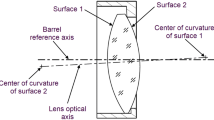Abstract
Precision geometry measurement of complex cutting tools has a significant impact on the machinability of components in the industry. However, acquiring high-quality images in machine vision is a challenging problem due to the large slope and complex geometry. In view of the vital function of illumination, this paper proposed a method of optimal design for the LED array. First, the calculation model of irradiance distribution on the measurement plane is established, and the properties of the reflected light from the surface of cutting tools are analyzed based on the BRDF theory. Then, the optimal parameters are solved through the specific algorithm flow for the LED array design. Finally, a flexible LED light source is fabricated with the optimal parameters for different features of the cutting tools and used in the measurement. The measurement results show that the error of the optimized light source is less than 1%, and compared with the off-the-shelf light, the measurement accuracy is improved by 9.5% on average. Moreover, this method also presents the potential applied to other complex objects.









Similar content being viewed by others
References
Alonso U, Calamaz M, Girot F, Iriondo E (2019) Influence of flute number and stepped bit geometry when drilling CFRP/Ti6Al4V stacks. J Manuf Process 39:356–370
Jia Z, Fu R, Niu B, Qian B, Bai Y, Wang F (2016) Novel drill structure for damage reduction in drilling CFRP composites. Int J Mach Tools Manuf 110:55–65
Petrò S, Moroni G (2020) 3D identification of face and flank in micro-mills for automatic measurement of rake angle. Nanomanufacturing and Metrology 3(2):151–163
Zhao T, Zhou J, Bushlya V, Ståhl J (2017) Effect of cutting edge radius on surface roughness and tool wear in hard turning of AISI 52100 steel. Int J Adv Manuf Technol 91(9):3611–3618
Hou Q, Sun J, Lv Z, Huang P, Song G, Sun C (2019) An online tool wear detection system in dry milling based on machine vision. Int J Adv Manuf Technol 105(1):1801–1810
Shuxia G, Jiancheng Z, Xiaofeng J, Yin P, Lei W (2011) Mini milling cutter measurement based on machine vision. Procedia Eng 15:1807–1811
Thakre AA, Lad AV, Mala K (2019) Measurements of tool wear parameters using machine vision system. Modelling and Simulation in Engineering, 2019
Qu Y, Hu Y, Zhang P (2018) Nonmechanical and multiview 3D measurement microscope for workpiece with large slope and complex geometry. J Microsc 272(2):123–135
Zhang H-L, Peng L, Luo Y-K, Yu S (2020) Rectangular illumination method using LED arrays for machine vision. Appl Opt 59(11):3518–3525
Dai Y, Zhu K (2018) A machine vision system for micro-milling tool condition monitoring. Precis Eng 52:183–191
Moreno I, Avendaño-Alejo M, Tzonchev RI (2006) Designing light-emitting diode arrays for uniform near-field irradiance. Appl Opt 45(10):2265–2272
Pal S (2015) Optimization of LED array for uniform illumination over a target plane by evolutionary programming. Appl Opt 54(27):8221–8227
Whang AJ-W, Chen Y-Y, Teng Y-T (2009) Designing uniform illumination systems by surface-tailored lens and configurations of led arrays. J Disp Technol 5(3):94–103
Moreno I, Muñoz J, Ivanov R (2007) Uniform illumination of distant targets using a spherical light-emitting diode array, vol 46
Su Z, Xue D, Ji Z (2012) Designing led array for uniform illumination distribution by simulated annealing algorithm. Opt Express 20(106):843–855
Chen Y, Ogata T, Ueyama T, Takada T, Ota J (2018) Automated field-of-view, illumination, and recognition algorithm design of a vision system for pick-and-place considering colour information in illumination and images. Sensors 18(5):1656
Wu X, Gao G (2018) LED light design method for high contrast and uniform illumination imaging in machine vision. Appl Opt 57(7):1694–1704
Watanabe W, Maruyama R, Arimoto H, Tamada Y (2020) Low-cost multi-modal microscope using Raspberry Pi. Optik 212:164713
Kim HT, Kim ST, Cho YJ (2015) Quick and efficient light control for conventional automatic optical inspection (AOI) systems. Int J Precis Eng Manuf 16(2):247–254
Zhou J, Yu J (2021) Chisel edge wear measurement of high-speed steel twist drills based on machine vision. Comput Ind 128:103436
Jahari M, Yamamoto K, Miyamoto M, Kondo N, Ogawa Y, Suzuki T, Habaragamuwa H, Ahmad U (2015) Double lighting machine vision system to monitor harvested paddy grain quality during head-feeding combine harvester operation. Machines 3(4):352–363
Torrance KE, Sparrow EM (1967) Theory for off-specular reflection from roughened surfaces. Josa 57(9):1105–1114
Kurt M, Edwards D (2009) A survey of BRDF models for computer graphics. ACM SIGGRAPH Comput Graph 43(2):1–7
Funding
This work was supported by the National Key Research and Development Project of China (Grant No. 2018YFA0703304), the National Natural Science Foundation of China (No. 52125504, 92148301), and the Natural Science Foundation of Liaoning Province of China (2020-BS-059).
Author information
Authors and Affiliations
Corresponding author
Ethics declarations
Conflict of interest
The authors declare no competing interests.
Consent for publication
All co-authors consent to the publication of this work.
Additional information
Author contribution
Wenqi Wang: conceptualization, data curation, formal analysis, methodology, supervision, validation, writing — original draft, writing — review and editing. Wei Liu: project administration, supervision, validation, funding acquisition, investigation, writing — review and editing. Yang Zhang: funding acquisition, investigation, project administration, writing — review and editing. Peidong Zhang: data curation, formal analysis, visualization, software. Likun si: investigation, resources. Mengde Zhou: investigation, resources.
Publisher’s note
Springer Nature remains neutral with regard to jurisdictional claims in published maps and institutional affiliations.
Rights and permissions
Springer Nature or its licensor (e.g. a society or other partner) holds exclusive rights to this article under a publishing agreement with the author(s) or other rightsholder(s); author self-archiving of the accepted manuscript version of this article is solely governed by the terms of such publishing agreement and applicable law.
About this article
Cite this article
Wang, W., Liu, W., Zhang, Y. et al. Illumination system optimal design for geometry measurement of complex cutting tools in machine vision. Int J Adv Manuf Technol 125, 105–114 (2023). https://doi.org/10.1007/s00170-022-10491-x
Received:
Accepted:
Published:
Issue Date:
DOI: https://doi.org/10.1007/s00170-022-10491-x




